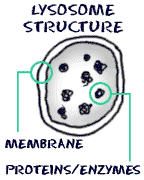3.2 Eukaryotic Cells
[TB] = Textbook definition [SG]= Study Guide Definition (used to give more variation in reading/understanding the definitions)
-Eukaryotic cells have a nucleus; a large structure that controls the workings of cell (contains genes)
-all cells (plants and animals) are surrounded by a plasma membrane.
FOR PLANTS:
Cell wall: protective barrier outside the plasma membrane of plant and certain other cells.
-made up of largely of cellulose fibers cemented together
-many plant cells have primary and secondary walls
~
~
-Eukaryotic cells have advantage over prokaryotic cells is because they have compartmentalization.
-with assortment of membrane-bound spaces (organelles), countless different reactions and processes can co-exist in eukaryotic cells without interfering one another. =more efficient, diversified, and specialized.
-functions in transport of materials in and out of cell. (recognition, communication, and homeostasis)
-membrane is selectively permeable (lets only certain things in)
-structure that has properties of a solid and liquid
-Forms “fluid sea” in which proteins and other molecules (lipids or carbohydrates) are anchored on various points on surface
-composed of side by side phospholipids arranged in a bilayer (lipid bilayer)
-each phospholipid had a hydrophobic tail and hydrophilic head
Useful definitions in this section:
THE NUCLEUS
Nucleus: specialized structure within cell which contains DNA and controls cell functioning and reproduction
-stores genetic info that determines the characteristics of body’s cell + metabolic functioning.
-each cell contains a complex copy of genetic info, but each cell type has certain genes of DNA on/off
-Activated DNA with RNA (intermediary), specifies sequence of amino acids during protein synthesis.
-proteins of cell determines structure + function
Nucleus has: nuclear membrane/envelope: the double membrane containing pores, which surrounds a nucleus. The nuclear membrane controls the passages of materials into and out of a nucleus.
Nuclear pores: opening in the nuclear envelope which permits the passage of proteins into the nucleus and ribosomal subunits out of the nucleus.
Nucleolus: Organelle where the rRNA is produced for ribosome formation
-nucleolus region looks darker
Nucleoplasm: the fluid of the nucleus. Chromatin (DNA) is suspended in the nucleoplasm. Chemical the nucleoplasm and the cytoplasm are very similar.
-A difference in pH between nucleoplasm and the cytoplasm, suggest they have different compositions.
Chromatin: Threadlike network in the nucleus that is made up of DNA and proteins.
Chromosomes: Rod-like structure in the nucleus that is made up of DNA and proteins
Useful Terms in this section:
Nucleoplasm [TB] [SG] Chromatin [TB] [SG] |
RIBOSOMES
Ribosome: Minute particle that is attached to the ER or occurs loose in the cytoplasm and is the site of protein synthesis.
Polyribosome: Cluster of ribosomes attached to the same mRNA molecule; each ribosome is producing a copy of the same polypeptide. (free-floating)
-proteins synthesized by the cytoplasmic ribosomes are used in the cell. (mitochondria, chloroplast etc.)
-contains rRNA and proteins
-made of 2 non-identical sub-units.
Useful terms in this section:
Polyribosome [TB] [SG] |
THE ENDOMEMBRANE SYSTEM
-consists of nuclear envelope, ER, Golgi apparatus, and vesicles
-system, compartmentalizes the cell so particular enzymatic reactions are restricted to specific regions.
-membranes that make the endomembrane system are connected by direct physical contact and or transfer of vesicles from on part to another.
-(SER collects steroid produced) (RER collected proteins produced) àsections of ER containing such products break free (blebbing) to produce small membrane bound sacs called vesicles (often called transition vesicles) enclosing the chemicals to be transported (most likely to Golgi).
Useful Terms in this section:
Vesicles [TB] [SG] Blebbing [TB] [SG] Transition vesicles [TB] [SG] SER [TB] [SG] RER [TB] [SG] |
THE ENDOPLASIC RETICULUM
Endoplasmic reticulum: membranous system of tubules, vesicles, and sacs in cells, sometimes having attached ribosomes. Rough ER has ribosomes. Smooth does not.
-system of membranous channels and saccules (flattened vesicles)
-physically continuous with outer membrane of nuclear envelope (branches throughout cytoplasm)
-Rough ER has ribosomes = protein synthesis à enter ER interior where processing/modification begins.
-Smooth ER has no ribosomes = synthesizes phospholipids and cholesterol (lipids required for growth of cell membrane) – testosterone & helps detoxify drugs.
-forms vesicles in which large molecules are transported to other parts of cell (often to plasma membrane or Golgi)
Useful Terms this section:
THE GOLGI APPARATUS
Golgi Apparatus: Organelle consisting of concentrically folded saccules, which functions in the packaging, storage and distribution of cellular products.
-Golgi consist enzymes that modify proteins and lipids
-newly manufactured protein à sorted out, labelled, packages into vesicles àpinch off > transport where needed.
-export= exocytosis
-involved in: modification, assembly, packaging, storage and secretion.
-involved in: modification, assembly, packaging, storage and secretion.
-ER cannot function efficiently in cells without the presence of Golgi.
-receive transition vesicles from ER—they concentrate the molecular contents of the vesicles and chemically adjust some of the molecules in preparation for their eventual secretion.
-New vesicles form by blebbing from Golgi (called secretory vesicles, contain biochemical that have been modified by Golgi)àmove and join cell membrane in a way that contents are expelled from the cell (exocytosis)
-The sequence of functional interrelationships among organelles is known as the secretory pathway.
Useful terms in this section:
LYSOSOMES
Lysosomes: membrane-bounded organelle containing digestive enzymes
-(produced by Golgi) -contains hydrolytic enzymes. (digest macromolecules from various sources)
Does:
1) cellular digestion
2) auto-digestion or disposal of damaged cell components
3) breakdown of whole cell (releasing contents into cytoplasm—sometimes called “suicide sacs”)
-Has 40 different enzymes- digest almost anything including proteins, RNA, DNA, carbohydrates and even helps destroy bacteria.
Lysosomes [TB] [SG] |
PEROXISOMES
Peroxisomes: enzyme-filled vesicle in which fatty acids and amino acids become hydrogen peroxide which is broken down to harmless products.
-remove hydrogen atoms from small molecules à join hydrogen atoms to oxygen to form hydrogen peroxide à (broken by enzyme “catalase) break down into water + oxygen
-synthesized by free ribosomes àimported directly into peroxisomes
-opposite of photosynthesis à uses oxygen and releases carbon dioxide
-abundant in cells that metabolizes lipids (liver metabolizes alcohol = help detox)
-plants àgerminating seeds (oxidizes fatty acids --) molecules converted to sugars)








No comments:
Post a Comment